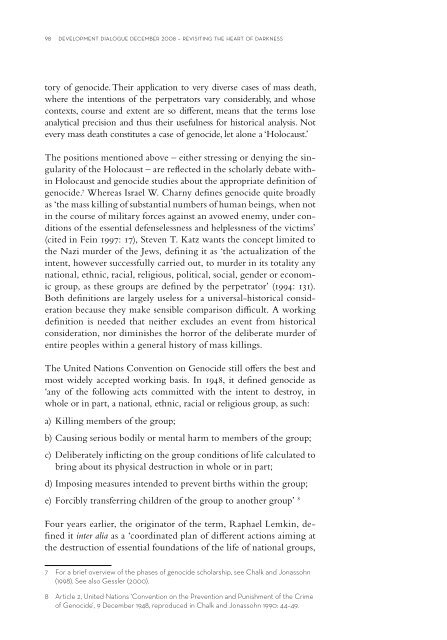60 years after the UN Convention - Dag Hammarskjöld Foundation
60 years after the UN Convention - Dag Hammarskjöld Foundation
60 years after the UN Convention - Dag Hammarskjöld Foundation
You also want an ePaper? Increase the reach of your titles
YUMPU automatically turns print PDFs into web optimized ePapers that Google loves.
98 development dialogue december 2008 – revisiting <strong>the</strong> heart of darkness<br />
tory of genocide. Their application to very diverse cases of mass death,<br />
where <strong>the</strong> intentions of <strong>the</strong> perpetrators vary considerably, and whose<br />
contexts, course and extent are so diff erent, means that <strong>the</strong> terms lose<br />
analytical precision and thus <strong>the</strong>ir usefulness for historical analysis. Not<br />
every mass death constitutes a case of genocide, let alone a ‘Holocaust.’<br />
The positions mentioned above – ei<strong>the</strong>r stressing or denying <strong>the</strong> singularity<br />
of <strong>the</strong> Holocaust – are refl ected in <strong>the</strong> scholarly debate within<br />
Holocaust and genocide studies about <strong>the</strong> appropriate defi nition of<br />
genocide. 7 Whereas Israel W. Charny defi nes genocide quite broadly<br />
as ‘<strong>the</strong> mass killing of substantial numbers of human beings, when not<br />
in <strong>the</strong> course of military forces against an avowed enemy, under conditions<br />
of <strong>the</strong> essential defenselessness and helplessness of <strong>the</strong> victims’<br />
(cited in Fein 1997: 17), Steven T. Katz wants <strong>the</strong> concept limited to<br />
<strong>the</strong> Nazi murder of <strong>the</strong> Jews, defi ning it as ‘<strong>the</strong> actualization of <strong>the</strong><br />
intent, however successfully carried out, to murder in its totality any<br />
national, ethnic, racial, religious, political, social, gender or economic<br />
group, as <strong>the</strong>se groups are defi ned by <strong>the</strong> perpetrator’ (1994: 131).<br />
Both defi nitions are largely useless for a universal-historical consideration<br />
because <strong>the</strong>y make sensible comparison diffi cult. A working<br />
defi nition is needed that nei<strong>the</strong>r excludes an event from historical<br />
consideration, nor diminishes <strong>the</strong> horror of <strong>the</strong> deliberate murder of<br />
entire peoples within a general history of mass killings.<br />
The United Nations <strong>Convention</strong> on Genocide still off ers <strong>the</strong> best and<br />
most widely accepted working basis. In 1948, it defi ned genocide as<br />
‘any of <strong>the</strong> following acts committed with <strong>the</strong> intent to destroy, in<br />
whole or in part, a national, ethnic, racial or religious group, as such:<br />
a) Killing members of <strong>the</strong> group;<br />
b) Causing serious bodily or mental harm to members of <strong>the</strong> group;<br />
c) Deliberately infl icting on <strong>the</strong> group conditions of life calculated to<br />
bring about its physical destruction in whole or in part;<br />
d) Imposing measures intended to prevent births within <strong>the</strong> group;<br />
e) Forcibly transferring children of <strong>the</strong> group to ano<strong>the</strong>r group’ 8<br />
Four <strong>years</strong> earlier, <strong>the</strong> originator of <strong>the</strong> term, Raphael Lemkin, defi<br />
ned it inter alia as a ‘coordinated plan of diff erent actions aiming at<br />
<strong>the</strong> destruction of essential foundations of <strong>the</strong> life of national groups,<br />
7 For a brief overview of <strong>the</strong> phases of genocide scholarship, see Chalk and Jonassohn<br />
(1998). See also Gessler (2000).<br />
8 Article 2, United Nations ‘<strong>Convention</strong> on <strong>the</strong> Prevention and Punishment of <strong>the</strong> Crime<br />
of Genocide’, 9 December 1948, reproduced in Chalk and Jonassohn 1990: 44–49.

















